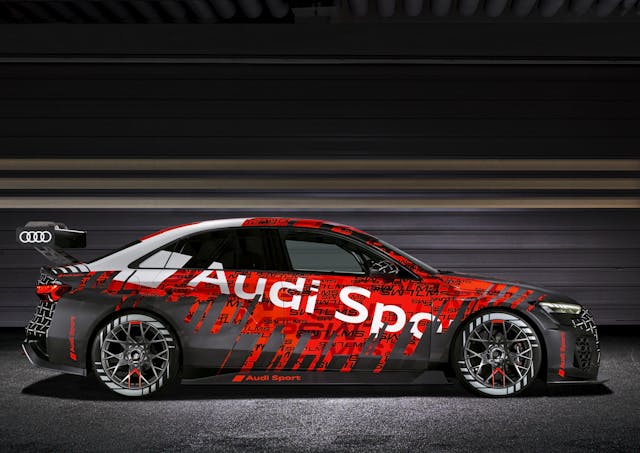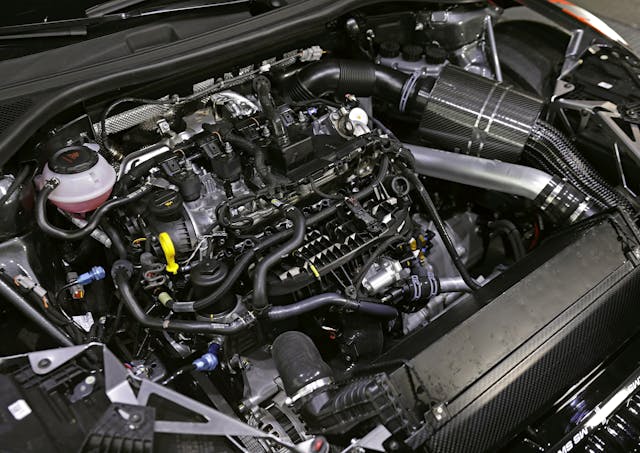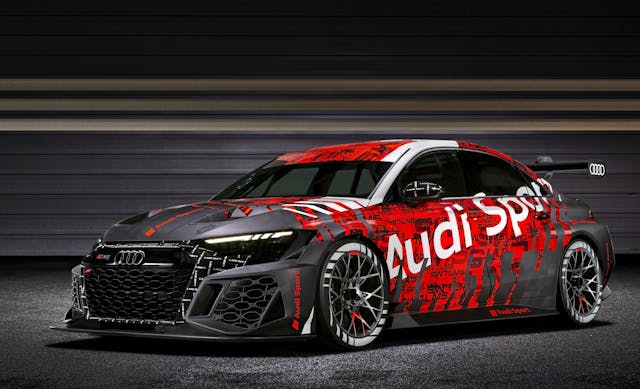Audi’s second-gen RS 3 LMS TCR race car looks ready to battle for podiums
Audi announced the second generation of its RS 3 LMS race car today, signaling its continued interest in the wildly popular, lower-cost TCR global class.
“The Audi RS 3 LMS is a clear commitment to customer racing and stands for records in our program,” said Julius Seebach, Managing Director Audi Sport GmbH. “We want to continue the remarkable series of successes of the first generation with the new model.”
That will be no easy feat; the first RS 3 LMS TCR car has racked up a rather impressive resume since debuting in late 2016. Audi built 180 units of the gen-one TCR race car for customers all over the world. In four years of competition, it racked up 764 podium places across 1051 races worldwide, including 279 victories.

The TCR class is flourishing under a new(ish) business model in racing, where OEMS build the cars and then sell them to privateer teams to race, offering varying levels of factory support with regards to maintenance and technical expertise. Expect the same sort of arrangement to continue with this second-gen unit. “The development goals for our latest model focused on the customers,” said Chris Reinke, Head of Audi Sport customer racing. “Whether it’s about running times or setup options, safety or ergonomics: we want to offer the teams a car that is even more of a race car than before.”
The new car features a host of improvements. The body shell of the second-gen car is as wide as legally allowed (1.95 meters) but features body extensions that are better integrated into the shape of the vehicle, which Audi says will be a boon for aerodynamics. Keeping performance parts cool under harsh racing conditions is always a challenge. To that end, Audi optimized the front apron for better brake and engine cooling, the latter of which utilizes radiators from the current R8 supercar.
Power comes from a lightly-modified version of the VW Group’s corporate workhorse, the 2.0-liter turbocharged EA888 engine. Race engines can get expensive quickly when they use bespoke pieces; part of what makes TCR so appealing is that a lot of the internals are not just derived from production models, they’re straight-up sourced from them. In this engine, the block, cylinder head, crank, valvetrain, intake manifold, fuel injection, and turbo are all straight from the road-going EA888. Only the valve cover breather (which needs an oil separator) and the exhaust differ from a road car. The engine is good for up to 340 horsepower, depending on specific series limitations.

That largely stock engine is mated to a Hewland six-speed pneumatically-actuated sequential automatic with a sintered twin-plate clutch. There’s a multi-plate limited-slip differential up front that Audi says is now easier to adjust for pre-load and stronger drive shafts on both driven wheels.
The new RS 3 LMS TCR features McPherson struts up front and a four-link system in the rear. To help with adjustability, the new car now has easily-interchangeable shims in the front control arms and track rods, allowing teams to adjust the front camber from two degrees to as high as seven degrees. There are nine different stabilizer settings on the front suspension, and six settings on the rear.
Under that shapely body lies an advanced safety cage constructed from more than 28 yards of steel tubing. There’s a six-point safety harness for the driver, as well as a roof hatch to extract the driver through in the event of a particularly nasty accident that requires that the spine be stabilized. The new car now comes standard with a polycarbonate rear window that’s lightweight and extremely impact-resistant.
On the whole, this is a pretty badass looking package. We’re excited to see the car line up against other TCR contenders from the likes of Honda, Hyundai, and Mazda in races across the globe.


